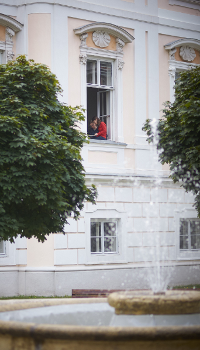History of Palais Strozzi
Maria Katharina countess Strozzi, née Khevenhüller (1633-1714), acquired 1699 a few plots of land – mostly vineyards – in the area called „dürres Lerchenfeld“, where she built a small summer residence with a large garden extending to the Piaristengasse until 1702, possibly by Johann Lucas von Hildebrandt. The remaining estate which was not used for the construction of the palace evolved to the Strozzigrund suburb.
After the death of Maria Katharina Strozzi in 1714 the palace was inherited by her nephew Johann Ludwig count Khevenhüller who sold it to Antonio Francesco Folco de Cardona, archbishop of Valencia, in 1716. He expanded the palace with single-storey wings and a forecourt. Whilst the Strozzigrund suburb succeeded to his nephew Johann Basilius Castelvi de Cervellon and finally to the City of Vienna in 1753, the palace was assigned to Emperor Charles VI., whose daughter Maria Theresia allocated it to her chancellor Johann Karl count Chotek, who liquidated a part of the garden.
After Chotek’s death in 1787, the palace passed to his nephews, yet they did not permanently occupy the building: in 1828 it was home to portrait painter Friedrich Amerling and a hospital during the cholera epidemic in 1831/1832. In 1838, the palace passed into state property and was commuted into the k. k. Zivilmädchenpensionat, an institution for the schooling of female teachers. The building was heightened in 1853; in 1877 and 1878 the neoclassical part on the frontage was errected. The Zivilmädchenpensionat was resident in the palace until 1919.
From 1940 to 2012 it was home to the Financial Office, so it is for the Institute for Advanced Studies since 2015.

